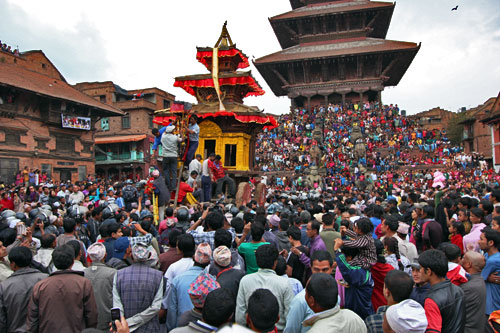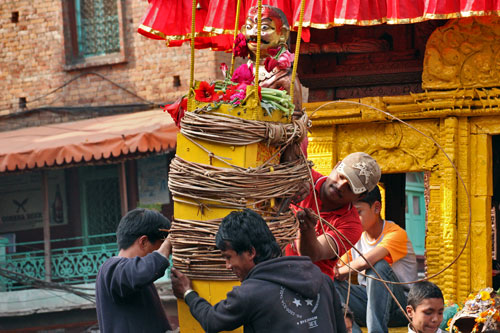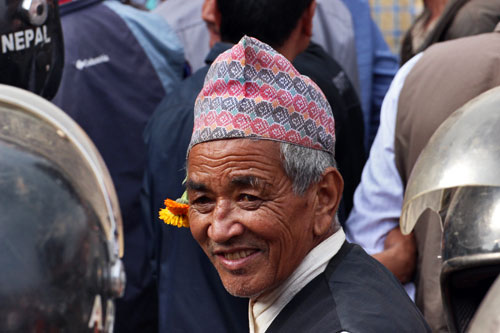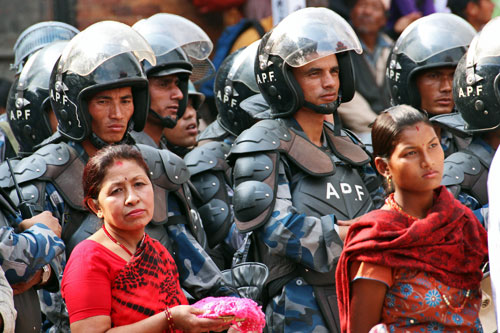At least one person dies each year at the Bisket Jatra Festival (Nepali New Year) in Bhaktapur, Nepal. This year, I was nearly one of them.
Last year, I had planned to attend Bisket Jatra for two reasons: it is the most elaborate celebration of Nepali New Year in the entire country; more importantly it was the only one of the seven UNESCO World Heritage Sites in the Kathmandu Valley that I had not yet visited. But the gods conspired against me. By the time I had been embarrassed at Boudhanath Temple and forcibly ejected from Pashupatinath Temple, I cut my losses and fled to Pokhara, leaving Bhaktapur for another time. This year, nothing was going to stop me.

Bisket Jatra is celebrated over nine days in mid-April in the ancient city of Bhaktapur, center of the Newaris who were early inhabitants of the Kathmandu Valley. For two weeks prior to the holiday, crews decorate an enormous wooden chariot in the center of Taumadhi Square in preparation for carrying the sacred image of the God Bhairav. Considered to be a dangerous deity, Bhairav is symbolically tied to his seat with scores of lengths of reed, which are painstakingly woven around the prow of the chariot where he is seated.

Upon completion of the chariot, thick ropes are unfurled from both ends and sent hand over hand into the ecstatic revelers. Men, young and old, grab hold of the ropes and attempt to drag the chariot from the neutral square to their respective sides of town; an ancient tug-of-war that is believed to bestow good luck the following year to the side that is successful.


Knowing that the event always results in casualties due to the massive number of spectators it attracts and the historically poor crowd control, I had scoped out the site a day earlier to identify a safe spot from which I could film and take photos. On the appointed day, I climbed up on a small stone platform in the center of the square, raised about two feet higher than the surrounding plaza, where I would be front and center yet safe from the crowd. As the finishing touches were being applied to the chariot, thousands of Newaris surged into the square and fought their way toward the center. Shoulder-to-shoulder spectators, many carrying young children on their shoulders, jockeyed for position as a police riot squad tried to maintain space between crowd and chariot.

A moment later a roar went up from the crowd as the ropes were deployed and any semblance of order evaporated. The rope-pullers shifted toward my platform, pushing the crowd in my direction. Spectators crushed between the tug-of-war and the platform had no choice but to jump up. Too late, I realized that there was nowhere for me to go.

Trapped and inexorably being pushed backward by the advancing crowd, I frantically looked for the edge of the platform but the crush of bodies blocked my view. One step more and the ground dropped out from under me. For a split second, I was suspended in mid-air by the mass of bodies before tumbling backward. I now know the meaning of the phrase “time stood still.” Everything happened in slow motion, as if my brain was recording it frame by frame. What seemed an eternity later but was in reality only seconds, my back hit the sharp stones of the pavement and I snapped back to real time. Dozens of feet trampled me as I screamed, “Help me up!”
Half a dozen men reached down, plucked me from the ground, and stood me upright. They passed me, hand over hand, to the edge of the square, where I would be safe. Once I stopped shaking, I checked my camera. I had never stopped filming, not even as I pitched off the platform. One person died and several were injured this year at Bisket Jatra. I am decidedly grateful not to have been one of them.

That’s really a lot of people in a narrow street there! I guess, Chinese New Year in China isn’t that bad afterall. 🙂
Too scary Barbara! I’m glad someone helped you and you didn’t get hurt!
Barbara, that is a bit close for comfort. Congrats on visiting all seven of the superb UNESCO sites in Kathmandu, captured so beautifully in prose and pictures as always. I have seen six of them in my visits (without being aware of them being listed) but without the drama and excitement that you have managed in your visits!!
Scary seeing that on video. I’m glad you were able to get out of there okay. It’s so difficult to control crowds when they are that large and participating in a giant tug of war.
Wow so intense! Love the pic of the soldiers…
Wow! Bet you’ll seek higher ground next time! I’ve been to that square, but in more peaceful times. Generally, I tend not to plan to attend large celebrations as they can get out of hand really fast. However, when I do happen to be in the right place at the right time for a celebration of some kind (unplanned), I’m almost always glad I’m there. Oktoberfest comes to mind.
Are things quieter in Pokhara now? As politics goes, things are just warming up for the fall election here in the states. But it’s still nothing like “warming up” in Nepal! As is the case everywhere, people just can’t seem to compromise.
Be safe.
Hi Steve: things are totally quiet in Pokhara now, especially since it’s the monsoon season and all the tourists are gone. I rather like it this way.
That is a scary story! Pleased you made it out ok – and well done on capturing the whole thing on video 😀
Thanks Laurence – me too!
That is so frightening! None of this will deter me from exploring Kathmandu, but I might choose the more peaceful places to visit.
Hi Sandra: Well, I wouldn’t call Kathmandu peaceful for the most part, but it is fascinating, and never really scary, except for almost being trampled to death, but that festival happens only once per year 🙂
Through all of that Kathmandu is still at the top of my list.
Hi LifePart2: LOL! Yes, even though Kathmandu is at times frustrating and exhausting, there is nowhere else like it on the face of the earth and it MUST be seen!
I’m glad that those men picked you up and delivered you to safety. I had my own near death experience too just over 24 hours ago. Where I live in Morwell in the state of Victoria, Australia, we had totally out of the blue a 5.4 magnitude earthquake. My apartment shook and rattled violently for at least 10-15 seconds with items falling off the shelves. This was my very first earthquake in what is normally a relatively earthquake safe region. Just like you I was left very shaken, in my case for a number of hours afterwards. Fortunately I’ve felt no aftershocks since but it certainly made me reflect and contemplate being in the present moment and the impermanent nature of things.
Matthew! So glad you are OK. We had a 4.8 magnitude quake here in Pokhara, Nepal, just a couple of weeks go, also an area that rarely feels this. And they seem to follow me around. Had a 6.2 in Lima, Peru and a 6 in Arusha, Tanzania. Makes me wonder what’s going on with this ‘ole earth and as you say, certainly makes us appreciate living in the present moment.